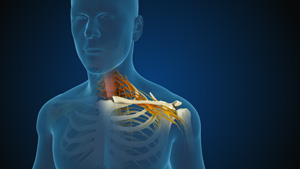
What is Cervical Myelopathy?
Cervical myelopathy is a disorder resulting from severe spinal cord compression in the cervical spine. The spinal cord in this region can become compressed as a result of bulging or herniated discs, spinal trauma, or spondylosis with arthritis and bone spurs causing severe pain, weakness, numbness, and even bowel and bladder changes. It can also lead to balance issue, gait instability, and decreased hand dexterity. Cervical spine surgery is the only effective way to treat cervical myelopathy.
Cervical Spine Anatomy
The cervical spine contains the spinal cord. The spine consists of 33 vertebral bones stacked one on top of the other with cushioning discs lying between each vertebrae. It is divided into 7 cervical vertebrae (neck), 12 Cervical vertebrae (mid back), 5 lumbar vertebrae (lower back), 5 sacral bones, and 4 coccyx bones. The sacral and the coccyx bones are fused and do not provide any movement in the spine. The spine plays a key role in the smooth movement, stability, and protection of the delicate spinal cord, and giving symmetry and support to the body.
Causes of Cervical Myelopathy
Cervical myelopathy typically develops due to gradual degeneration of the spine as well as compression of the spinal cord resulting from conditions such as:
- Spinal stenosis
- Autoimmune disorders, such as rheumatoid arthritis of the spine
- Hematomas, cysts, hernias, and spinal tumors, including bone cancer
- Spinal trauma, spinal infection, neurological disorders, inflammatory disease, radiation therapy
- Congenital disorders
- Central disc herniations
Symptoms of Cervical Myelopathy
Usually, spinal cord trauma or compression results in loss of function, loss of sensation, and discomfort or pain around the area. Cervical myelopathy symptoms may also include:
- Numbness, tingling, or weakness
- Neck, arm, lower back or leg pain
- Difficulty walking
- Difficulties with balance and coordination
- Loss of bowel or urinary control
- Increased or abnormal reflexes in the extremities
- Complications with fine motor skills, such as buttoning a shirt or writing
Diagnosis of Cervical Myelopathy
Proper diagnosis is crucial for effective management of cervical myelopathy. To arrive at an accurate diagnosis, a detailed review of medical history coupled with a physical and neurological examination is conducted. Neurological examination helps identify any signs of neurological injury and involves evaluation of reflexes and muscle weakness. Your doctor may also recommend the following tests for a detailed view of the spine and spinal canal to assess for any abnormalities and to confirm the diagnosis of cervical myelopathy:
- X-ray
- MRI scan
- Electrical tests, such as somatosensory evoked potentials or electromyogram
Treatment for Cervical Myelopathy
Treatment usually depends on the causes of cervical myelopathy. Surgery has been shown however to be the only effective treatment method which prevents progression of symptoms.
Surgical Treatment
Cervical spine decompression surgery is the common surgical treatment employed to treat spinal cord compression.
Decompression surgery is designed to take the pressure off the spinal cord and prevent progression of symptoms and provide relief from pain and discomfort.
For cervical myelopathy that occurs because of stenosis (narrowing of the spinal canal), your physician may recommend a surgery called laminoplasty. Laminoplasty is a motion-sparing procedure that creates more space for the spinal cord and nerve roots to relieve abnormal pressure on the spinal cord while retaining flexibility of the spine at the area of compression.
For patients who are not a candidate for laminoplasty, decompression and spinal fusion is employed as an alternative. During spinal fusion, two or more vertebrae are fused together so that they heal into a single, solid bone. This is done to eliminate painful motion and to restore stability to the spine.
Cervical herniated disc surgery such as an ACDF or cervical arthroplasty is also an option to eliminate herniated discs or bone spurs that are found to be pressing against the spinal cord causing myelopathy.
These surgeries can be performed by certain surgeons with minimally invasive spine surgery techniques. Minimally invasive spine surgery offers lower risks and complications with a faster recovery due to minimal surgical incisions and reduced trauma to the body when compared to conventional open surgery. This type of surgery is usually performed using microscopic instruments and a microscope to visually guide the surgery.















